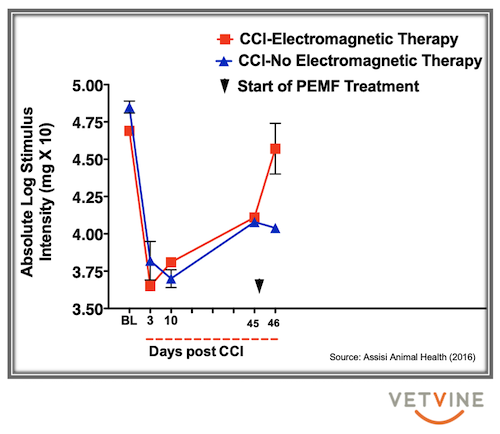Forums
Guidance, support and wisdom to benefit and maximize the life and longevity of animals.

VetVine Client Care

Neuropathic pain in veterinary patients presents one of the more challenging conditions to manage - often chronic, multifactorial, and resistant to conventional pharmacologic therapies. Integrative medicine offers a multimodal framework for addressing the complex interplay of nervous system dysfunction, inflammation, and emotional stress that can accompany these cases.
These integrative modalities are among those that have demonstrated benefits for managing patients with neuropathic pain and can be used alone or in combination:
PEMF therapy is the delivery of a low-level microcurrent that is generated by an electromagnetic field. The effects on tissue are enhanced nitric oxide production and modulation of cellular responses to injury and trauma. Studies in rodent and diabetic neuropathy models have shown that PEMF can improve neuronal survival (in conditions associated with reduced blood flow and hypoxia), promote nerve regeneration, and decrease allodynia.
In a blinded study of rats with chronic sciatic nerve constriction (CCI), PEMF-treated animals demonstrated significantly decreased allodynia compared to controls:

Clinically, this modality has become a mainstay for many rehabilitation practitioners due to its anti-inflammatory and neuroprotective effects. PEMF is noninvasive, well-tolerated, and – unlike laser or water treadmill therapy – can easily be administered by clients at home. In some neurologic patients, especially those regaining sensation after long-term neuropathy, transient “pins and needles” reactions may occur. These are generally self-limiting and managed by shortening treatment durations for several days before gradually increasing exposure.
Underwater treadmill therapy remains a cornerstone for patients with neurologic deficits and peripheral neuropathies. The rotating treadmill belt provides neurosensory feedback that encourages locomotion and proprioception, while warm water offers buoyancy, circulatory support, and resistance – which promotes strength and endurance.

Neurologically impaired dogs that are unable to walk on land often demonstrate improved mobility in water; The hydrostatic pressure reduces joint loading and the warmth enhances tissue perfusion. Even partial gait recovery achieved through hydrotherapy can significantly improve quality of life and neuromuscular re-education in patients with neuropathies.
Low-level laser therapy (LLLT) exerts both analgesic and anti-inflammatory effects by enhancing nitric oxide release and blocking depolarization of C-fiber afferent (pain) nerves. The result is attenuation of pain transmission and improved microcirculation in tissues.
While robust veterinary studies are limited, clinical outcomes support its inclusion in the multimodal management of pain — particularly for neuropathic conditions where inflammation and aberrant nerve firing coexist.
Therapeutic massage not only improves circulation and flexibility but also directly influences the sensory and autonomic nervous systems – including reflexes that decrease blood pressure, slow breathing and improve digestion. Evidence from both human and animal studies have demonstrated that massage reduces cortisol and epinephrine levels while increasing serotonin.
In veterinary patients, massage can decrease pain perception, lower stress, and improve emotional wellbeing. It is also one of the most accessible integrative interventions for owners to perform at home.
Acupuncture’s analgesic mechanisms are multifactorial, involving local, spinal, and supraspinal effects. Insertion of a needle stimulates a local axon reflex, leading to vasodilation, mast cell activation, and the release of neuropeptides. These biochemical events, combined with altered blood flow, contribute to both localized and systemic pain relief.
Early, groundbreaking research in the area of acupuncture demonstrated – incredibly – that cerebrospinal fluid (CSF) collected from acupuncture-treated rabbits increased pain thresholds when injected into untreated rabbits (who were then subsequently exposed to painful stimuli).
Acupuncture also has an analgesic effect via induction of the endogenous descending pain control pathways that modulate nociceptive signals at the level of the brain and spinal cord – enhancing serotonin and norepinephrine. Synergistic effects have also been reported when electroacupuncture was combined with pharmacologic agents such as amitriptyline or NMDA antagonists, making it a valuable adjunct in complex neuropathic cases and chronic pain conditions.